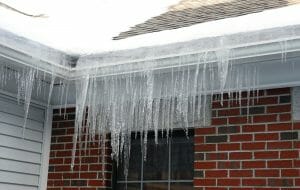
Taking care of your home in the winter can seem like a constant challenge. Even if you live in an area where snow and ice are only occasional problems, they can cause a surprising amount of damage before you realize anything is wrong. Your gutters are designed to carry water away from the roof to keep it dry and free of rot.
However, both snow and ice can interfere with this function and lead to water that backs up under the shingles instead. Find out how to protect your gutters from the top to the bottom of the home and keep winter damage from leading to costly roof repairs in the spring.
Snow and Ice Weight
The sheer weight of ice and snow weighing on your gutters can damage them. Gutters are designed to handle a little extra weight as water runs through them or leaves temporarily build up. But since snow and ice are both compacted forms of water, they can weigh far more as the material builds up along the edge of the roof.
Even icicles hanging from the gutters pull on them, increasing the chances of detachment. This can be dangerous to anyone walking around the edges of the roof or damage your car and landscaping. Checking the attachment of the gutters to the fascia boards in the fall is important, but preventing ice and snow build-up in the winter is also essential to preventing this problem.
Blocked Downspouts
One commonly overlooked problem created in the gutter system during most winters is ice blocking one or more downspouts. The downspouts that connect to the gutters still need to carry water away from the foundation when a warm day or direct sun melts some of the snow on the roof. Buried downspouts can be heated with underground cables or simply buried deep enough for your area to stay below the frost line.
This will keep them insulated thanks to the power of dirt alone. Another option for preventing downspout blockages is detaching them in the fall at the surface and keeping them cleared out manually or with heating cables. Since the amount of water traveling through your gutters is usually reduced in the winter, allowing it to escape over the frozen ground is unlikely to be a problem. This should help you at least detect when ice blockages have formed and access the downspout to correct the problem.
Ice Damming on the Roof
Gutters should help prevent ice damming, but often they encourage it instead. Ice damming is a problem where snow builds up on a roof, then melts because heat is rising through the attic and warming the roof. Ice forms along the edge as it refreezes, creating a dam. Water can’t run off into the gutter, so it soaks through the roof instead.
While you need to primarily address this problem with better roof insulation to keep the roof cold and frozen, improving your gutters can also work to control the issue. Heating cables encourage faster runoff and prevent ice dams from forming, but they only work if the gutters are clear and ready to accept water.
Using gutter guards or covers built to withstand the weight of snow can help prevent clogged gutters that refuse to drain. Don’t add heating elements to a roof that receives snow in the winter without first ensuring that the gutters can handle the water that will form from the melting effect.
Gutter Guards for Snow and Ice
Not all gutter guards work equally well for snow and ice management. Mesh and perforated screen designs tend to work best because water can easily flow through them even when covered in snow. Foam guards are not the best choice for cold climates because they can freeze solid with ice and block the flow of water or become compressed by its weight. They’re also less compatible with heating cables to keep ice from forming dams along the edges of the roof than mesh or perforated designs.
Watching for Winter Emergencies
No matter what kind of gutter guards you install or how well your gutters are attached to your home, you’ll still need to watch out for heavy snowfall that happens during blizzards and other winter emergencies.
Unexpected weight can damage any kind of gutters, no matter how well-attached they are. In the case of heavy snowfall, you may want to use a snow rake or hire a company to blow snow off of your roof so there’s no chance of damage to the structure or gutters. Temporarily adding heating cables to the roof edges may help as well if snow is expected to build up over the course of a few days.
Choose K-Guard to install the highest quality gutter guards on your home before winter storms arrive for the year. Don’t let snow and ice catch you unaware and damage your gutters when we can help.
This post first appeared on https://www.kguard.com